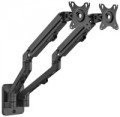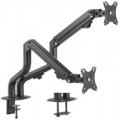Type
—
Wall mount. Device for attaching the TV to the wall; it attaches directly to the surface, without additional items. Such an installation will be especially useful in small rooms where the area does not allow the use of a floor stand. However mounting to the wall requires certain labor costs (for example, a concrete wall will have to be drilled).
—
Ceiling mount. Device for attaching the TV to the ceiling. As well as wall-mounted, it does not require additional equipment, pieces of furniture, etc., and allows you to save space, however, installation is associated with some difficulties, and it is inconvenient to constantly watch TV with your head up. Therefore, such a mount is designed primarily for public places, where it is important to protect equipment from theft and vandalism.
—
Desktop mount. Device for mounting the screen on a table or similar surface. The specific installation method may be different: among desktop models, there are both stands without additional clamps, and stands with clamps and/or bolt-through fastening (see "Installation"). However, anyway, desktop models are intended mainly for monitors — in cases where their own stand is either completely absent in the design, or does not fit in one way or another.
—
Floor mount. Stand designed for installation on the floor. Usually it is not rig
...idly fixed, it can be rearranged if desired, there are even models with wheels. Unlike various stands (see below), it is designed primarily to accommodate a TV, and any additional shelves are the exception rather than the rule. The advantage of floor mounts is ease of installation, the disadvantage is the need for space on the floor.
— Stand. The stand in this case is a separate piece of furniture with one or more shelves, and sometimes even drawers. The TV on the stand is installed on the top shelf on its own stand, and the remaining shelves can be used to place additional equipment (for example, a DVD player or media centre) or other items. Such stands are as simple as possible to install and use — they are simply placed on the floor, like ordinary tables. They also have practically no compatibility problems: the working part is a regular flat surface suitable for any complete stand (within certain dimensions and weight, of course). The main disadvantage is the space occupied on the floor, due to which the stands are poorly suited for tight spaces. In addition, installing a TV on its own stand is somewhat less reliable than on a mount, because. there is a possibility of overturning (albeit very small).
— Stand with mount. A kind of stand (see above), equipped with its own TV mount. Retaining most of the advantages of classic stands (easy to install, additional shelves), this design provides increased reliability — you can overturn the TV only together with the cabinet, which is almost impossible to do by accident. At the same time, the presence of a mount reduces versatility compared to conventional stands — not every TV can fit under it.Installation
Method of table mount installation (see "Type") to the tabletop.
This parameter is specified for those models that have additional devices for fixing on the table — a
clamp, a platform for
bolt-through mounting, or both. In addition, there are ordinary
stands that do not have fixing devices; they are as simple as possible to install and move from place to place, but they are not very reliable.
As for the different installation methods, their features are as follows:
— Clamp. Fixation with a clamp attached to the edge of the table. Clamps are more limited in their choice of mounting location than bolts — such a mount cannot be installed in the middle of a countertop. At the same time, such installation is much easier both during the initial installation and when moving the structure from place to place: there is no need to drill a table, preparing a place for bolts. And the limited choice of location is often compensated by an abundance of adjustments that allow you to set the optimal position of the screen. Due to this, clamps are the most popular in desktop mounts.
— Bolt-through mounting. Mounting with bolts through holes in the countertop. The main advantages of this option are reliability, as well as the ability to choose the installation point almost anywhere on the countertop. On the other hand, the installation procedure itself
...is quite complicated and involves permanent placement in one place, without moving — after all, it is necessary to drill holes for the bolts. Therefore, such a method of installation in its pure form is extremely rare nowadays — universal mounts have become more common (see below).
— Universal. Mounts that allows two mounting options described above at once — using a clamp to the edge of the countertop or using bolts. This design allows you to choose the best option. At the same time, it is technically easy to provide both a clamp and the possibility of bolt-through installation in one mount; therefore, most mounts with the possibility of using bolts are universal.Max. size
The maximum size of the TV screen that can be installed on the stand/mount. Like the minimum size (see above), it is in some way a conditional indicator — TVs with a larger size can also fit for the mount, and then the main determining parameter will be the maximum weight (see below).
Max. weight
The maximum weight of the TV that can be installed on the mount/stand; more specifically, it is the maximum weight that the mount/stand can support for an indefinitely long time without any negative consequences. Unlike the screen size described above, this parameter is accurate and should not be exceeded: perhaps the stand/mount will not break immediately under excess weight, but this can happen at any time, and such a breakdown is not covered by the warranty.
It is worth considering that for classic stands with several shelves (see "Type"), the maximum wheight is usually indicated for the entire structure as a whole and is the sum of the loads for each individual shelf. Thus, the maximum weight of the TV is not limited by the total maximum wheight, but by the maximum wheight for one shelf. This does not apply to stands with mounts; they usually list the maximum wheight on the mount, in which case it corresponds to the maximum weight of the TV.
The screen size is directly related to the maximum wheight (after all, a large TV weighs more). Typically, for screens up to 24", structures with a maximum wheight of about 5-6 kg are usually quite enough, for a 32" device, about 12 kg may be needed, large 55" screens reach a maximum weight of about 25-30 kg, and in the case of plasma panels, these figures increase by 1.5-2 times However, anyway, before choosing, you should clarify the weight of the specific TV model for which the stand/mount is selected.
Minimum distance from the wall
The smallest possible distance between the wall on which the mount is hung and its farthest protruding point. First of all, the overall compactness of the design depends on the minimum distance: if you do not want the TV to protrude far forward from the wall, you should pay attention to models with a small minimum distance. And if the mount provides length adjustment, this parameter determines the limits of such adjustment.
Max. distance from wall
The maximum distance from the TV mounting point to the wall (in the case of ceiling mounts, to the ceiling) provided by the mount. See "Minimum distance from wall" for details.
Turn angle
The angle within which the screen installed on the mount can rotate. Measured from far left to far right. In modern models, it can reach 180°.
Rotation angle
The angle within which the screen installed on the mount can rotate. Rotation refers to turning around a horizontal axis perpendicular to the screen; see "Adjustments" for details. And the angle is usually indicated from one extreme position to another.
According to this parameter, two categories of mounts can be distinguished. In one of them, the rotation angle is small — about 10 – 15 ° — and this feature is mainly intended to compensate for inaccuracies made during the installation of the structure: even if the mount hangs slightly unevenly,
rotation allows you to set the screen straight. The second variety is models with a rotation angle of 180° and above (up to 360°); they allow user to rotate the screen from landscape to
portrait and vice versa.

